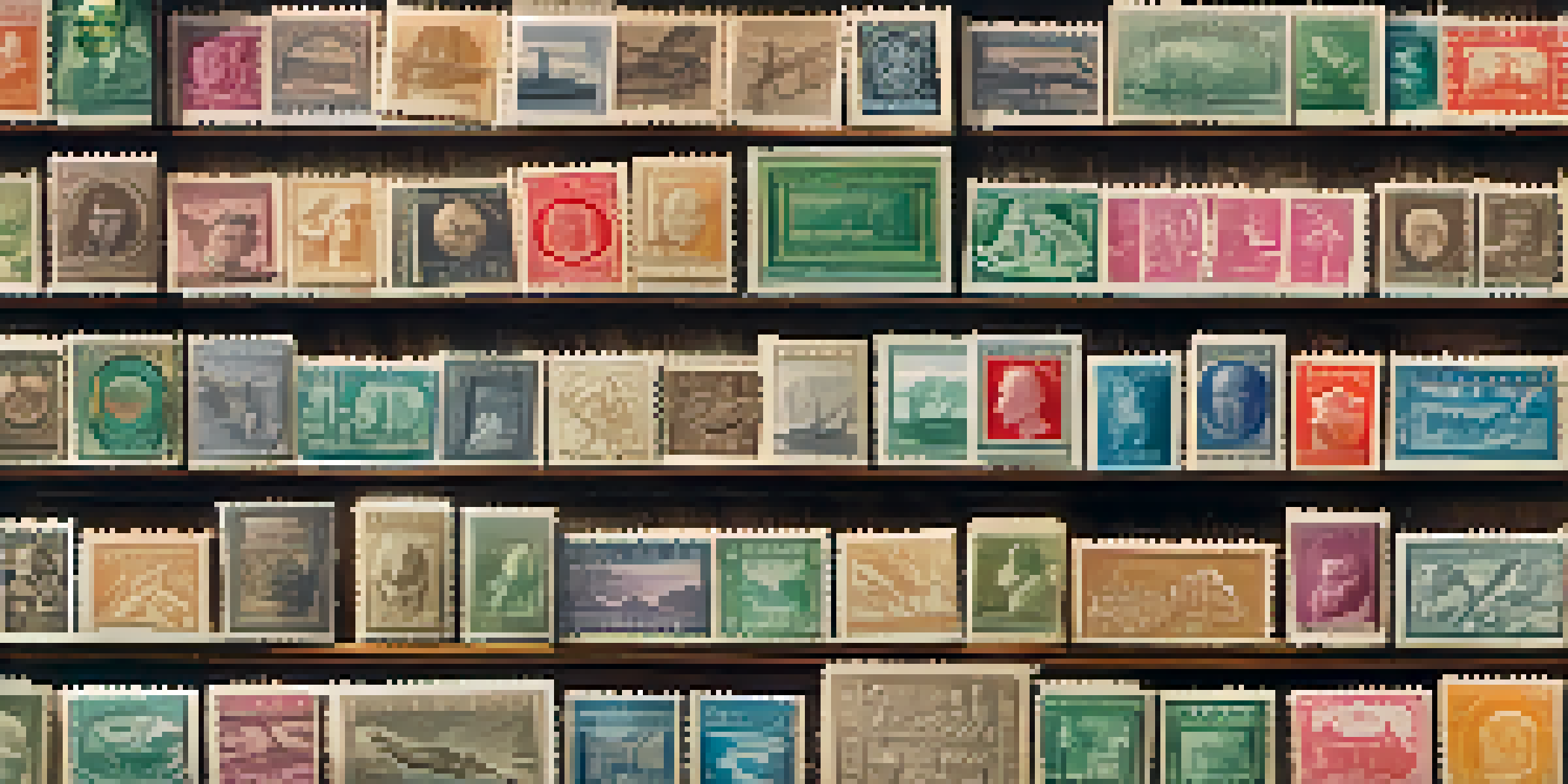Understanding Stamp Catalogs: A Collector's Essential Tool

What is a Stamp Catalog and Why is it Important?
A stamp catalog is essentially a comprehensive guide that lists stamps from various countries, detailing their designs, values, and production dates. For collectors, this tool is indispensable, as it helps them understand the context and history behind each stamp. Think of it as a treasure map; without it, you might miss out on valuable finds or even buy fakes unknowingly.
The best way to learn about stamps is to collect them.
Moreover, a catalog provides a standardized way to categorize and value stamps, which is crucial for trade or sale. As stamp collecting can be a financial investment, knowing the worth of your collection helps you make informed decisions. It’s like having a financial advisor who specializes in your unique hobby.
In summary, a stamp catalog not only enhances your collecting experience but also arms you with knowledge, making your journey through the world of philately much more rewarding.
Types of Stamp Catalogs: Which One Should You Choose?
There are various types of stamp catalogs available, each catering to different needs and preferences. For example, some catalogs focus on specific regions or countries, while others provide a global overview. This diversity allows collectors to choose a catalog that best aligns with their interests, whether they're into rare finds or common stamps.

Additionally, catalogs can be organized in different formats, such as printed books or online databases. Online catalogs often have the advantage of being updated frequently, which is crucial in a hobby where values and availability can change rapidly. It’s like choosing between a classic recipe book and an ever-evolving cooking app; both have their benefits, but one might suit your lifestyle better.
Importance of Stamp Catalogs
A stamp catalog serves as a comprehensive guide, helping collectors understand the value and history of stamps while protecting their investments.
Ultimately, your choice of catalog should reflect your collecting style and goals, ensuring you have the right tools to guide your stamp journey.
How to Use a Stamp Catalog Effectively
Using a stamp catalog might seem straightforward, but there are tips and tricks to maximize its effectiveness. Start by familiarizing yourself with the catalog’s layout and organization—take note of how stamps are categorized and indexed. This foundational knowledge will save you time as you search for specific stamps or information.
A stamp collects more than just postage; it collects history.
Next, cross-reference your stamps with the catalog to verify their details and values. This process can be akin to detective work, where each stamp tells a story and your catalog is the key to unlocking it. Finding out that your stamp is rare or valuable can bring a delightful surprise!
Lastly, keep your catalog handy while attending stamp shows or auctions. It’s an essential resource that can help you make quick assessments, ensuring you don't miss out on great deals or overpay for common stamps.
The Role of Condition in Stamp Value: What to Know
The condition of a stamp plays a crucial role in its value, and this is where a stamp catalog becomes invaluable. Most catalogs include grading systems that help collectors assess the quality of their stamps. Understanding these conditions—such as mint, used, or damaged—will influence your purchasing and selling decisions.
For instance, a mint condition stamp can fetch a significantly higher price than its used counterpart. Imagine finding an old coin; its value can vastly differ depending on its wear and tear. A catalog provides the guidelines to help you determine which stamps are worth the investment based on their condition.
Choosing the Right Catalog
With various types of catalogs available, collectors should select one that aligns with their interests and collecting goals.
In essence, being knowledgeable about stamp conditions not only protects your investment but also enhances your overall collecting experience.
Understanding Catalog Numbers: Decoding the System
Every stamp in a catalog is assigned a unique catalog number, which is essential for identification and valuation. This number serves as a shorthand reference that collectors use to discuss and trade stamps efficiently. Think of it as a social security number for stamps; it helps you pinpoint exactly which stamp you’re talking about without confusion.
Understanding catalog numbers can also aid in managing your collection. By using these numbers, you can easily track which stamps you have and which ones are still on your wishlist. It simplifies your collecting journey, allowing you to focus more on the joy of collecting rather than the logistics.
Therefore, familiarizing yourself with catalog numbers is key to navigating the world of stamps and ensuring that you communicate effectively with fellow collectors.
Online Resources vs. Printed Catalogs: Pros and Cons
In today’s digital age, collectors often face the choice between online resources and traditional printed catalogs. Each option has its own set of advantages. Online catalogs are typically more up-to-date, allowing for real-time price changes and availability, which can be a game-changer for savvy collectors.
On the other hand, printed catalogs provide a tactile experience that many collectors cherish. There's something comforting about flipping through pages filled with colorful stamps. It can feel more personal and engaging, much like reading a book versus scrolling on a screen.
Condition Affects Stamp Value
The condition of a stamp significantly influences its value, making it essential for collectors to understand grading systems.
Ultimately, many collectors find value in using both formats. Online catalogs for quick updates and printed ones for leisurely browsing create a balanced approach to stamp collecting.
The Future of Stamp Catalogs: Trends to Watch
As technology continues to evolve, so too does the world of stamp catalogs. One trend to watch is the increasing integration of augmented reality (AR) features, which could allow collectors to visualize stamps in 3D. This could transform how collectors interact with their catalogs, making the experience more engaging and informative.
Additionally, the rise of mobile applications for stamp collecting is changing the game. These apps can provide real-time updates, community features, and instant access to vast databases. It’s reminiscent of how smartphones have changed our daily lives, making information more accessible and interactive.

As we look to the future, it’s exciting to think about how these innovations will enhance the stamp collecting experience, making it more dynamic and connected than ever before.